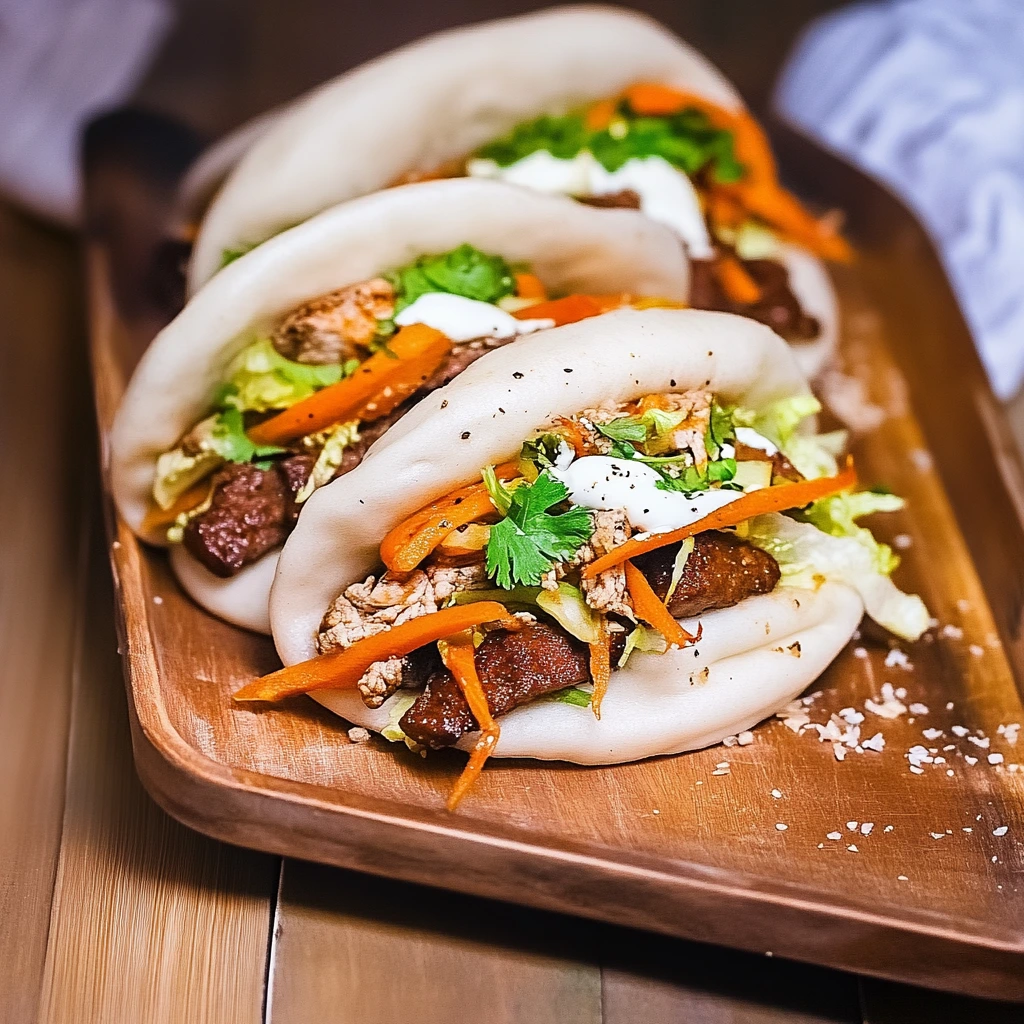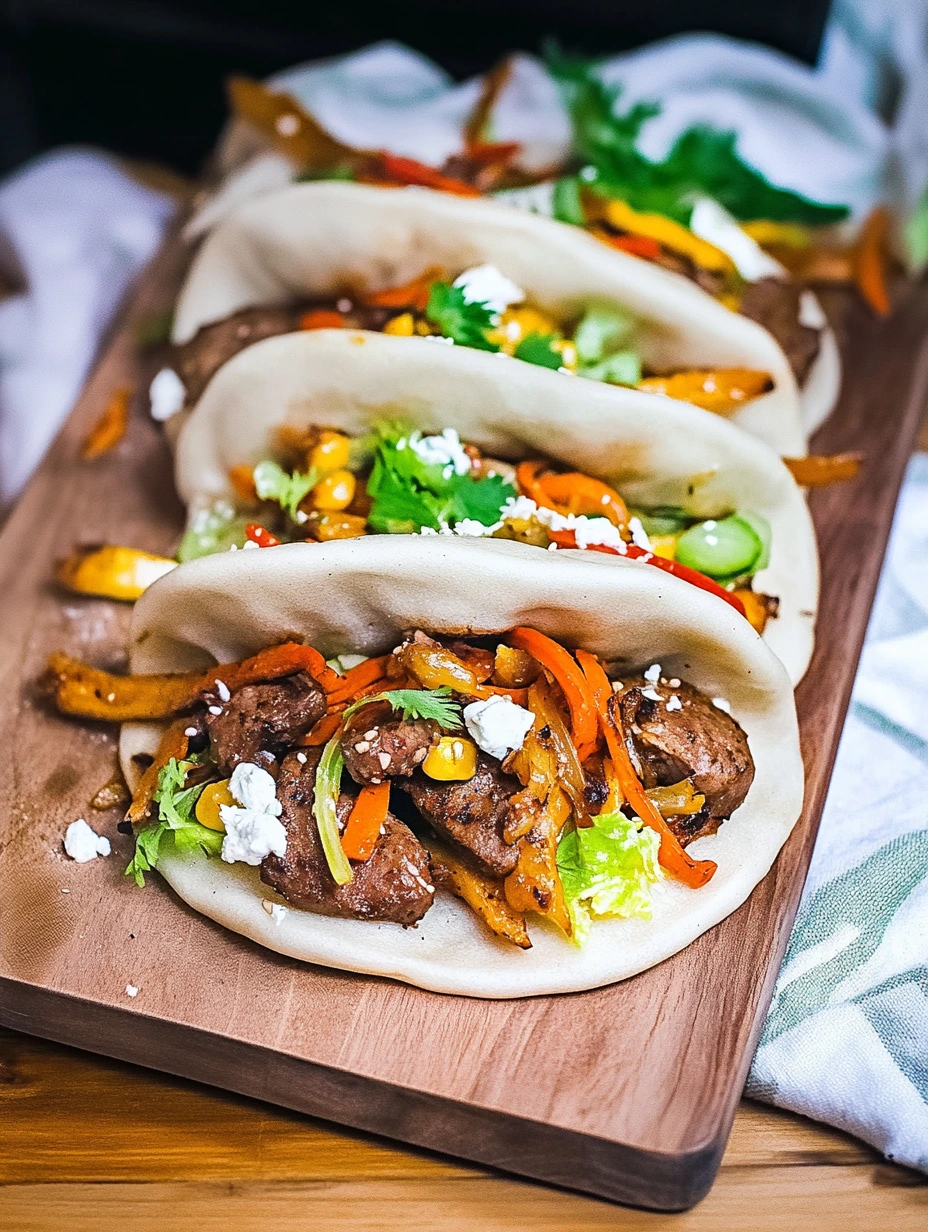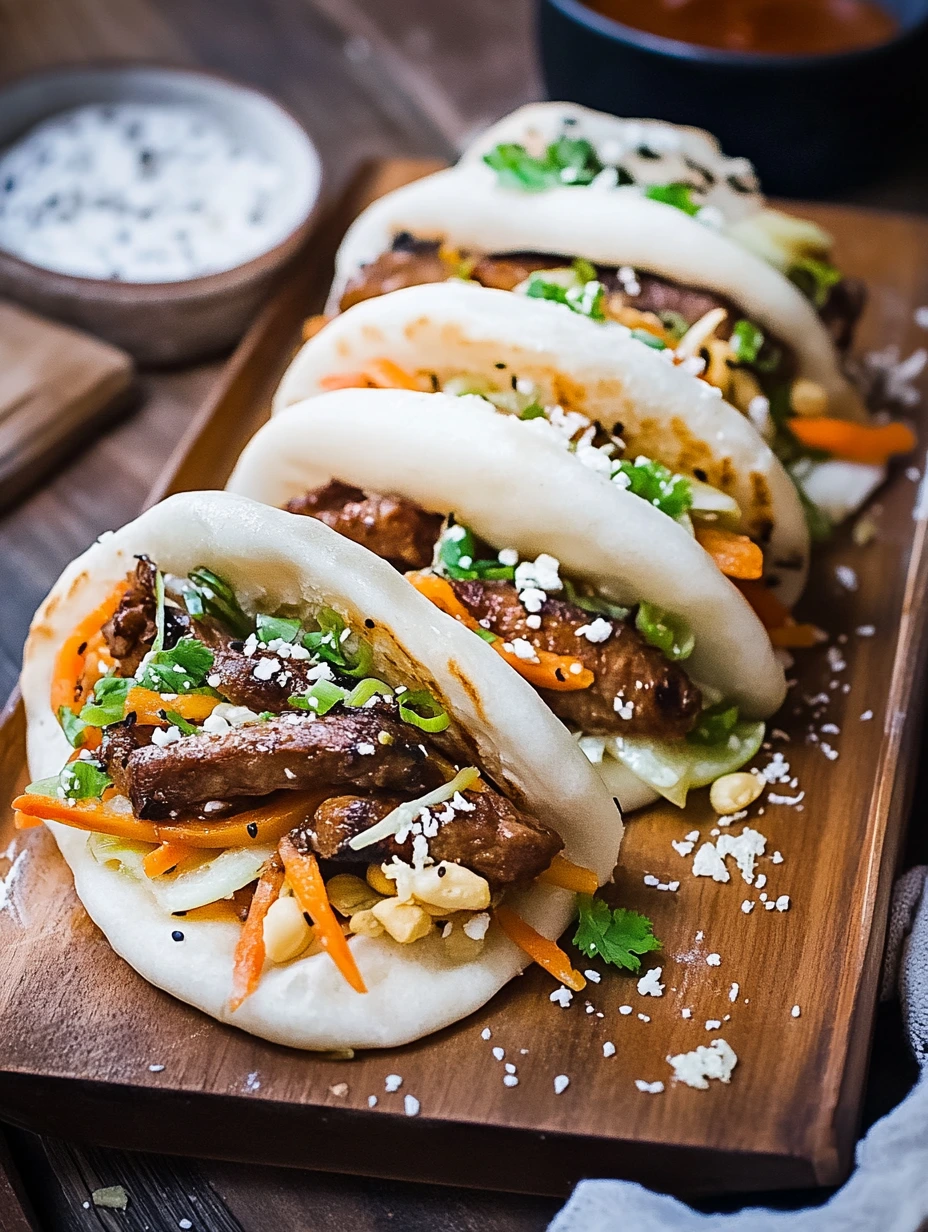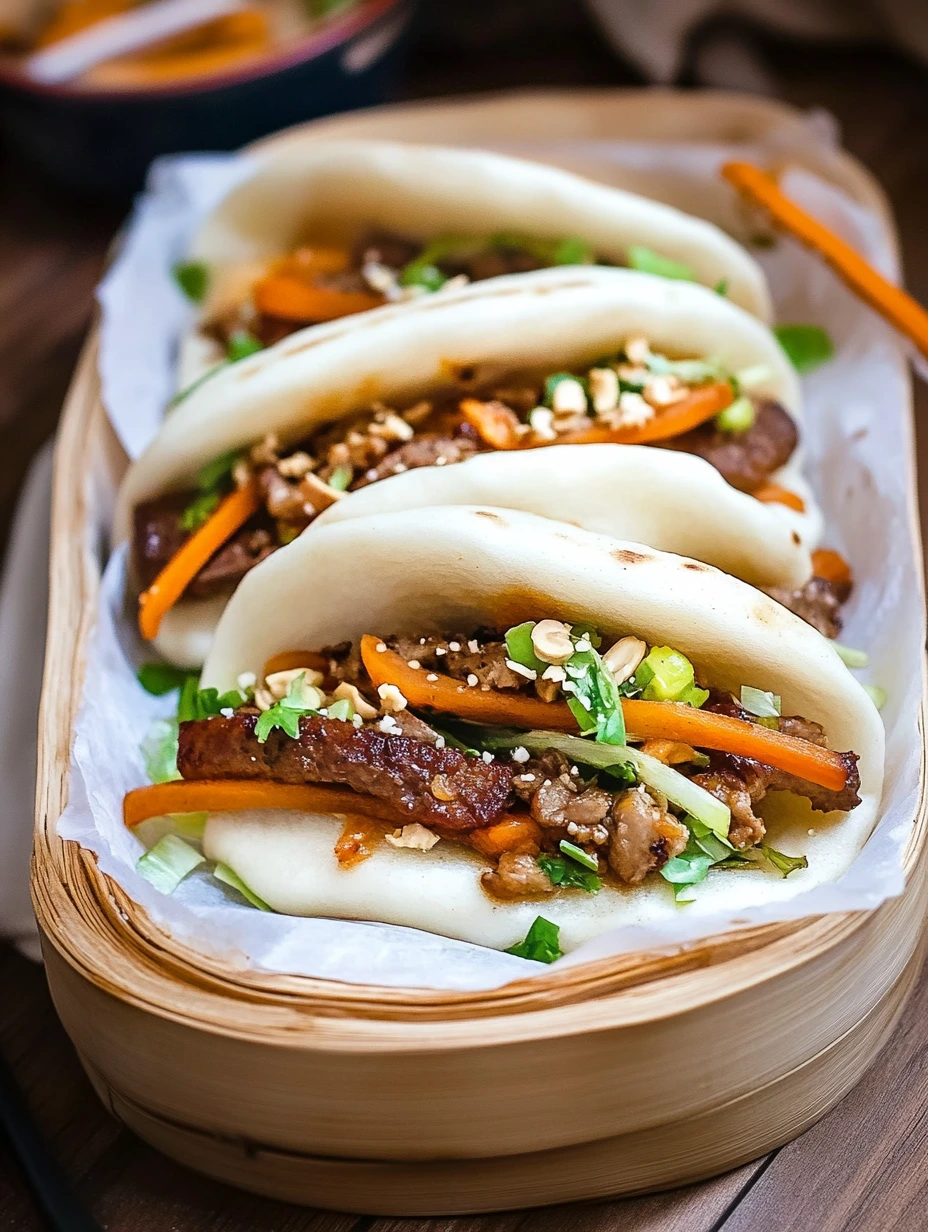 Pin it
Pin it
Soft steamed buns with a tasty filling - these veggie and ground meat gua bao will take you straight to Taiwan's busy streets with their comforting, genuine flavors. These fluffy steamed pockets combine tender ground meat with crisp fresh veggies, all wrapped in an incredibly soft bun. It's an easy food adventure you can enjoy without leaving your kitchen.
I first tried gua bao during my trip to Asia and fell in love with their airy texture and complex taste. After trying a few times in my kitchen, I managed to recreate that food magic that my family now asks for every Sunday dinner.
Secrets for perfect dough
- T80 wheat flour: Go for this semi-whole flour that brings more flavor and nutrients than regular white flour while staying light and airy, which you need for soft buns.
- Baker's yeast: Active dry yeast works best as it stores well and mixes nicely with dry flour before adding liquids, making sure everything blends evenly.
- Warm water: The best temp is between 35-40°C, warm enough to wake up the yeast but not hot enough to kill it, which matters a lot for good rising.
- Unrefined sugar: It's not just for taste - it feeds the yeast and helps with color, even when steaming, so try to use unprocessed sugar for better flavor.
- Olive oil: A bit of good olive oil makes the buns softer and helps them stay fresh longer, so you can make them ahead of time.
 Pin it
Pin it
Getting the steamed buns ready
In a big bowl, mix the T80 flour with dry yeast, a tiny bit of salt and unrefined sugar. This step really matters to get all the dry stuff mixed properly before adding any wet ingredients. Make a hole in the middle and slowly pour in warm water while gently pulling flour from the sides to the center.
The right way to knead
After the water's mixed in, add olive oil and start kneading on a lightly floured surface. You'll need to knead for about 10 minutes until the dough feels smooth, stretchy and doesn't stick to your fingers. This work helps develop the gluten that gives your buns their special texture.
Giving it time to rest
Put your dough in a slightly oiled bowl, cover with a damp cloth and let it sit somewhere warm without drafts for about an hour. During this time, the dough should double in size as the yeast works to turn sugars into carbon dioxide, creating air pockets that will make your buns fluffy.
Gentle shaping
When the dough has risen well, gently press it down with your palm. Then cut it into equal pieces of about 50 grams each. Shape each piece into a ball, flatten it slightly, and brush with a bit of oil to keep it from drying out.
The folding method
Roll each piece of dough into an oval about 12 cm long and 8 cm wide. Then fold it in half without pressing the edges, like a little open book, putting a small piece of parchment paper between the halves so they don't stick together during steaming.
 Pin it
Pin it
Steam cooking
Place the folded buns in your steamer basket with enough space between them since they'll grow bigger. Cover and steam for 10-12 minutes after the water starts boiling. The buns should come out puffy, soft and slightly shiny, showing they're perfectly cooked.
Making the tasty filling
In a hot pan, cook your ground meat with a bit of sesame oil for that classic Asian flavor. Throw in some finely chopped garlic and ginger to add subtle aroma. Then mix in crunchy veggies like grated carrots, bean sprouts and sliced green onions for texture and freshness.
Balanced seasoning
For flavoring, mix soy sauce with a little honey or brown sugar, a dash of sesame oil and maybe some sriracha if you like heat. Pour this sauce over your meat and veggie mix, let it cook down a bit so all the flavors soak in nicely.
Putting it all together
Carefully open your warm steamed buns and fill them generously with the meat and veggie mixture. Top with fresh cilantro leaves, crushed peanuts and maybe a cucumber slice for extra freshness and crunch.
My favorite thing about this recipe was discovering how amazing steamed bread feels in your mouth. This old-school cooking method creates a softness and lightness I'd never tried before. My whole family was blown away by the result, and even those who don't usually like foreign foods fell for these soft buns that just melt in your mouth.
Mix-ins and side dishes
These yummy gua bao can be paired with lots of things to make a full, balanced meal. A simple cucumber salad with sesame dressing adds freshness and lightness. For a more authentic experience, serve them with lightly salted edamame and some homemade pickled veggies like carrots or radishes soaked in rice vinegar, sugar and salt. A light mushroom broth with shiitake and wakame seaweed perfectly rounds out this Asian food journey. For special occasions, pair your gua bao with a light craft beer or jasmine green tea that nicely balances the flavors.
Creative twists
This basic recipe can easily change with your mood and the seasons. For a veggie version, swap the ground meat for finely chopped mushrooms and crumbled tofu for a similarly satisfying texture. Seafood fans can try shrimp marinated in soy sauce and ginger, quickly pan-fried. For something richer, try shredded duck confit with homemade hoisin sauce. If you like stronger flavors, add some kimchi to your filling for a surprising Korean twist. In summer, a fresher version with grilled chicken, mango and fresh herbs completely changes the experience.
Storage tips
If you want to make these gua bao ahead of time, the steamed buns freeze really well. Let them cool completely after cooking, then wrap them individually in plastic wrap before putting them in a freezer bag. They'll keep for up to two months this way. To reheat, put them straight from the freezer into a steamer for about 5 minutes without thawing first, and they'll be just as soft as freshly made. The filling can also be made ahead and kept in the fridge for 48 hours in an airtight container. Gently warm it in a pan, adding a splash of water if needed, before stuffing your freshly heated buns.
 Pin it
Pin it
This gua bao recipe really shows what creative, world-inspired cooking is all about. I love how a traditional Taiwanese dish can work with our local ingredients while keeping its soul and technique. These steamed buns perfectly match my cooking philosophy: respecting tradition while daring to make some personal tweaks. Every time I make these gua bao for my family, I feel that special joy of sharing not just food but also a cultural and sensory journey. Cooking has this unique power to take us places and bring us closer together, and these little buns show that perfectly.
Frequently Asked Questions
- → Can I make the bao dough the day before?
- Sure! Make the dough the night before, then let it slowly rise in the fridge. Take it out 30 minutes early to warm up, and continue shaping and cooking as usual.
- → How should I store cooked bao buns?
- They freeze perfectly! Wait until they're completely cool, wrap each in plastic, and freeze. Heat them up directly in the steamer for 3-4 minutes when you're ready to eat.
- → What other fillings can I use?
- Get creative! Fill them with barbecue pork, marinated chicken, grilled tofu for veggie options, or shiitake mushrooms. Add classic veggies like marinated cucumbers, grated carrots, and fresh cilantro for an extra punch.
- → I don’t have a steamer; what can I do?
- No problem! Use a big pot with boiling water and a strainer or bamboo basket on top. Cover it to trap the steam. Add 5 minutes to the steaming time for best results.
- → What flour makes fluffier bao buns?
- For super white and soft buns like in restaurants, go for white wheat flour (T45 or T55). Use about 140 ml water (instead of 150 ml) since these flours absorb a bit less.
